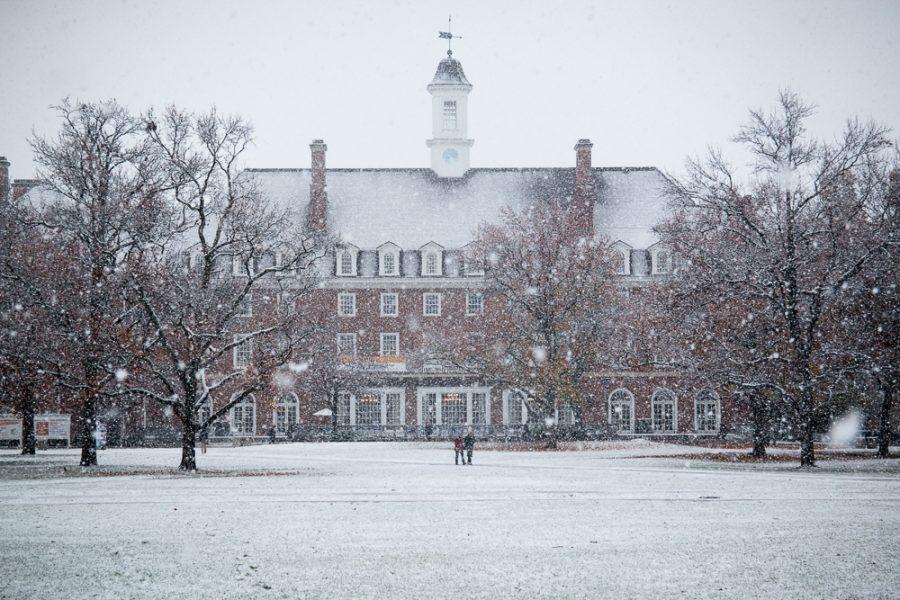Future of winter term uncertain
A photo of the Illini Union in the snow on Dec. 4, 2017.
Mar 9, 2017
The University is debating whether to permanently offer classes during winter break, including during years with a short turnaround between the fall and spring semesters.
The winter session launched in 2014 as a pilot program, with eight online classes and 980 students. Three years later, it has grown to 24 classes with 1,819 students.
The initial trial period ended at the start of 2017. The Academic Senate initially approved the experiment with the assumption that the winter session would not be offered during years with shorter breaks.
However, some people who want to make the session permanent argue that every undergraduate class, except for the seniors, have had the option to enroll in a winter class their entire college career, and may plan their schedules around it.
Nearly half of the students enrolled in a winter class this year did so to fulfill a general education requirement, according to the winter 2017 Illinois online courses survey. Twenty-nine percent took an elective, and 26 percent took a core class in their major.
Get The Daily Illini in your inbox!
“We want to benefit students in their studies, so they can finish the requirements on their degrees or even minors more efficiently,” said Frank Liu, a business administration professor and one sponsor of the new proposal.
If approved, the session would start the first Friday after the fall semester ends and finish the Saturday before the spring semester begins. In years with short winter breaks, the class websites would open a week early to accommodate students.
The question at the center of the debate is whether professors can teach and students can learn in that amount of time. Stephen Altaner, associate geology professor, thinks it is possible.
He teaches natural disasters in person during fall and spring semesters, online for eight weeks in the summer session and online for four weeks in the winter session. He includes the same content in all three courses, but he adds more challenging assignments online since the classes are smaller.
Altaner said students tend to be more engaged during the winter term, possibly since they only take one class.
“I get great discussions going, and I offer extra credit that students have just taken and gone with, and really excelled finding stories about natural disasters, posting and discussing them. That has just exploded in popularity,” he said.
Eric Snodgrass, director of undergraduate studies for the Department of Atmospheric Sciences, has taught the severe and hazardous weather course all three winter sessions. He thinks it is possible for students to tackle the class in a shortened time frame, but he does not know if it would be in students’ best interest.
“To have a 3-week winter session where immediately following finals one semester, you’re taught a completely accelerated course schedule ending immediately before the start of the spring semester, it could add undue and unwanted stress,” he said.
Taking a winter class can also be costly for students. While they pay a flat rate for fall and spring semesters, students pay per credit hour during summer and winter sessions. Financial aid is generally not available.
In-state freshmen, sophomores and juniors who took a winter course in 2016 paid $402 per credit hour, costing them $1,206 for a three credit hour class. Tuition varies for out-of-state freshmen, sophomores and juniors, but they paid about double what in-state students paid.
Colleges receive a higher percentage of tuition dollars in the winter and summer than they do during fall and spring semesters. This comes amidst cutbacks because of the budget impasse.
Colleges receive 90 percent of tuition dollars, and the remaining 10 percent goes to the University’s general fund, according to Kathy Martensen, assistant provost for educational programs. The formula is more complicated for fall and spring semesters, where colleges receive less money.
Winter session has generated $5.8 million for participating colleges during its three year pilot program.
The business administration department offers the most winter classes, with five this year. Associate department head Jeffrey Loewenstein maintains that revenue was not the motive behind offering the classes.
“We’re making more students be able to fulfill their goals, and we’re able to run the courses with the revenue coming in and cover that time and those resources,” he said.
The Academic Senate’s educational policy committee will vote on making the winter session permanent. Bettina Francis, educational policy committee chair and associate entomology professor, anticipates that the committee will make a decision sometime before April’s Academic Senate meeting, where the proposal would receive a final vote.






